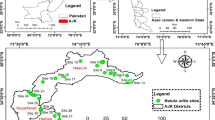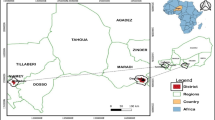Abstract
In South America, the largest area of tropical savanna is the Brazilian Cerrado biome, which encompasses a considerable range of environmental variation, with different types of soil, geology, geomorphology and climate, as well as distinct types of vegetation. These savannas include two types of vegetation: one on hilly slopes, with relatively shallow interspersed with rocky soils (RS), known as Rocky Cerrado, and the other located on flat terrain with deep soils (DS), known as Typical Cerrado. Our objective was to evaluate the effects of the heterogeneity of the chemical and granulometric properties of the soils on the composition and diversity of the shrubby–arboreal strata of the RS and DS. We found that, despite the reduced abundance of woody plants in the RS, and the physical limitations on plant development imposed by the rocky outcrops found in this environment, the RS is characterized by similar species diversity to that found in the DS. We present evidence of greater heterogeneity in the species composition and edaphic proprieties of the RS in comparison with the DS. We conclude that the greater variation and heterogeneity in the substrates of the RS accounts for the similarity in the species diversity between the RS and DS, although we suspect that other drivers, not investigated here, may also be involved. The intense conversion of native vegetation within the study region interferes with the establishment of exclusive species in RS (e.g., Norantea guianensis Aubl.) and DS (e.g., Couepia grandiflora (Mart. & Zucc.) Benth.) and consequently threatens the community structure of both environments with fundamental implications for the conservation.



Similar content being viewed by others
References
Abreu MF, Pinto JRR, Maracahipes L et al (2012) Influence of edaphic variables on the floristic composition and structure of the tree-shrub vegetation in typical and rocky outcrop cerrado areas in Serra Negra, Goiás State, Brazil. Braz J Bot 35:259–272. https://doi.org/10.1590/S1806-99592012000300005
Anderson MJ (2001) A new method for non parametric multivariate analysis of variance. Austral Ecol 26:32–46. https://doi.org/10.1111/j.1442-9993.2001.01070
Anderson MJ (2006) Distance-based tests for homogeneity of multivariate dispersions. Biometrics 62:245–253. https://doi.org/10.1111/j.1541-0420.2005.00440.x
Anderson MJ, Ellingsen KE, McArdle BH (2006) Multivariate dispersion as a measure of beta diversity. Ecol Lett 9:683–693. https://doi.org/10.1111/j.1461-0248.2006.00926.x
APG IV (2016) An update of the Angiosperm Phylogeny Group classification for the orders and families of flowering plants: APG IV. Bot J Linn Soc 181:1–20
Asner GP, Knapp DE, Broadbent EN, Oliveira PJC, Keller M, Silva JN (2005) Selective logging in the Brazilian Amazon. Science 130:480–482
Benites VM, Caiafa AN, Mendonça ES, Schaefer CE, Ker JC (2003) Solos e vegetação nos complexos rupestres de altitude da Mantiqueira e do Espinhaço. Floresta Ambient 10:76–85
Benites VM, Schaefer CEGR, Simas FNB, Santos HG (2007) Soils associated with rock outcrops in the Brazilian mountain ranges Mantiqueira and Espinhaço. Rev Bras Bot 30:569–577. https://doi.org/10.1590/S0100-84042007000400003
Collinson AS (1988) Tropical formations with conspicuous grasslands: savannas. In: Collinson AS (ed) Introduction to world vegetation. Unwin Hyman Ltd, London, pp 232–248
EMBRAPA (2006) Sistema brasileiro de classificação de solos. Centro nacional de pesquisa de solos, 2nd edn. Embrapa Solos, Rio de Janeiro
Ferreira JN, Bustamante MMC, Davidson EA (2009) Linking woody species diversity with plant available water at a landscape scale in a Brazilian savanna. J Veg Sci 20:826–835. https://doi.org/10.1111/j.1654-1103.2009.01076.x
Goedert WJ, Wagner E, Barcelhos AO (2008) Savanas Tropicais: dimensão histórica e perspectivas. In: Faleiro FG, Farias-Neto AL (eds) Savanas: Desafios e estratégias para o equilíbrio entre sociedade, agronegócio e recursos naturais. Embrapa Cerrados, Planaltina, pp 49–80
Gomes L, Lenza E, Maracahipes L et al (2011) Comparações florísticas e estruturais entre duas comunidades lenhosas de cerrado típico e cerrado rupestre, Mato Grosso, Brasil. Acta Bot Bras 25:865–875. https://doi.org/10.1590/S0102-33062011000400013
Gotelli NJ, Colwell RK (2001) Quantifying biodiversity: procedures and pitfalls in the measurement and comparison of species richness. Ecol Lett 4:379–391. https://doi.org/10.1046/j.1461-0248.2001.00230.x
Hammer Ø, Harper DAT, Ryan PD (2001) Paleontological statistics software package for education and data analysis. Palaeontol Electron 4:9–18. https://doi.org/10.1016/j.bcp.2008.05.025
Haridasan M (2000) Nutrição mineral das plantas nativas do cerrado. Rev Bras Fisiol Veg 12:68–83
IBGE (2004) Mapa de Biomas do Brasil, primeira aproximação. In: IBGE. www.ibge.gov.br
Klink CA, Machado RB (2005) A conservação do Cerrado brasileiro. Megadiversidade 1:147–155
Lemos HL, Pinto JRR, Mews HA, Lenza E (2013) Structure and floristic relationships between Cerrado sensu stricto sites on two types of substrate in northern Cerrado, Brazil. Biota Neotrop 13:121–132. https://doi.org/10.1590/S1676-06032013000400013
Lenza E, Pinto JRR, Pinto ADS et al (2011) Comparação da vegetação arbustivo-arbórea de uma área de cerrado rupestre na Chapada dos Veadeiros, Goiás, e áreas de cerrado sentido restrito do Bioma Cerrado. Rev Bras Bot 34:247–259. https://doi.org/10.1590/S0100-84042011000300002
Lima TA, Pinto JRR, Lenza E, Pinto ADS (2010) Florística e estrutura da vegetação arbustivo-arbórea em uma área de cerrado rupestre no parque estadual da Serra de Caldas Novas, Goiás. Biota Neotrop 10:159–166. https://doi.org/10.1590/S1676-06032010000200020
Lista de Espécies da Flora do Brasil (2015) Lista de Espécies da Flora do Brasil 2015. In: Jardim Botânico do Rio Janeiro. http://floradobrasil.jbrj.gov.br
Magurran AE (2011) Medindo a diversidade biológica. Universidade Federal do Paraná, Curitiba
Maracahipes L, Lenza E, Marimon BS et al (2011) Estrutura e composição florística da vegetação lenhosa em cerrado rupestre na transição Cerrado-Floresta Amazônica, Mato Grosso, Brasil. Biota Neotrop 11:133–141. https://doi.org/10.1590/S1676-06032011000100013
Maracahipes-Santos L, Lenza E, dos Santos JO et al (2015) Diversity, floristic composition, and structure of the woody vegetation of the Cerrado in the Cerrado–Amazon transition zone in Mato Grosso, Brazil. Braz J Bot 38:877–887. https://doi.org/10.1007/s40415-015-0186-2
Marimon Junior BH, Haridasan M (2005) Comparação da vegetação arbórea e características edáficas de um cerradão e um cerrado sensu stricto em áreas adjacentes sobre solo distrófico no leste de Mato Grosso, Brasil. Acta Bot Bras 19:913–926. https://doi.org/10.1590/S0102-33062005000400026
Méio BB, Freitas CV, Jatobá L et al (2003) Influência da flora das florestas Amazônica e Atlântica na vegetação do cerrado sensu stricto. Rev Bras Bot 26:437–444. https://doi.org/10.1590/S0100-84042003000400002
Messias MCTB, Leite MGP, Meira Neto JAA et al (2013) Soil-vegetation relationship in quartzitic and ferruginous Brazilian rocky outcrops. Folia Geobot 48:509–521. https://doi.org/10.1007/s12224-013-9154-4
Mews HA, Pinto JRR, Eisenlohr PV, Lenza E (2014) Does size matter? Conservation implications of differing woody population sizes with equivalent occurrence and diversity of species for threatened savanna habitats. Biodivers Conserv 23:1119–1131. https://doi.org/10.1007/s10531-014-0651-4
Mews HA, Pinto JRR, Eisenlohr PV, Lenza E (2016) No evidence of intrinsic spatial processes driving Neotropical savanna vegetation on different substrates. Biotropica 48:433–442. https://doi.org/10.1111/btp.12313
Moreira AG (2000) Effects of fire protection on savanna structure in Central Brazil. J Biogeogr 27:1021–1029
Motta PEF, Carvalho-Filho A, Ker JC et al (2002) Relações solo-superfície geomórfica e evolução da paisagem em uma área do Planalto Central Brasileiro. Pesqui Agropecu Bras 37:869–878. https://doi.org/10.1590/S0100-204X2002000600017
Oksanen J, Blanchet FG, Kindt R et al (2015) vegan: Community Ecology Package. In: R Packag. version 2.3-1. http://cran.r-project.org/package=vegan
Oliveira-Filho AT, Ratter JA (2002) Vegetation physiognomies and woody flora of the Cerrado Biome. In: Oliveira PS, Marquis RJ (eds) The Cerrados of Brazil: ecology and natural history of a Neotropical savanna. Columbia University Press, New York, pp 91–120
Pinto JRR, Lenza E, Pinto ADS (2009) Composição florística e estrutura da vegetação arbustivo-arbórea em um cerrado rupestre, Cocalzinho de Goiás, Goiás. Rev Bras Bot 32:23–32. https://doi.org/10.1590/S0100-84042009000100002
R Development Core Team (2015) R: a language and environment for statistical computing. R Foundation for Statistical Computing, Vienna, Austria. http://www.R-project.org/
Reatto A, Correia JR, Spera ST (2008) Solos do Bioma do Cerrado: aspectos pedológicos. In: Sano SM, Almeida SP, Ribeiro J (eds) Cerrado: ecologia e Flora. Embrapa-CPAC, Planaltina, pp 107–149
Ribeiro JF, Walter BMT (2008) As principais fitofisionomias do bioma Cerrado. In: Sano SM, Almeida SP, Ribeiro JF (eds) Cerrado: ecologia e Flora. Embrapa-CPAC, Planaltina, pp 151–212
Ruggiero PGC, Batalha MA, Pivello VR, Meirelles ST (2002) Soil-vegetation relationships in cerrado (Brazilian savanna) and semideciduous forest, Southeastern Brazil. Plant Ecol 160:1–16. https://doi.org/10.1023/A:1015819219386
Ruggiero PGC, Pivello VR, Sparovek G et al (2006) Relação entre solo, vegetação e topografia em área de cerrado (Parque Estadual de Vassununga, SP): como se expressa em mapeamentos? Acta Bot Bras 20:383–394. https://doi.org/10.1590/S0102-33062006000200013
Sano EE, Rosa R, Brito JLS, Ferreira LG (2010) Land cover mapping of the tropical savanna region in Brazil. Environ Monit Assess 166:113–124
Santos TRR, Pinto JRR, Lenza E, Mews HA (2012a) The tree-shrub vegetation in rocky outcrop cerrado areas in Goiás State, Brazil. Braz J Bot 35:281–294. https://doi.org/10.1590/S1806-99592012000300007
Santos TRR, Pinto JRR, Lenza E (2012b) Floristic relationships of the woody component in rocky outcrops savanna areas in Central Brazil. Flora 207:541–550. https://doi.org/10.1016/j.flora.2012.06.015
Silva DM, Batalha MA (2008) Soil-vegetation relationships in cerrados under different fire frequencies. Plant Soil 311:87–96. https://doi.org/10.1007/s11104-008-9660-y
Silva JMC, Bates JM (2002) Biogeographic patterns and conservation in the South American Cerrado: a tropical savanna Hotspot. Bioscience 52:225–233. https://doi.org/10.1641/0006-3568(2002)052[0225:BPACIT]2.0.CO;2
Silva JF, Fariñas MR, Felfili JM, Klink CA (2006) Spatial heterogeneity, land use and conservation in the cerrado region of Brazil. J Biogeogr 33:536–548. https://doi.org/10.1111/j.1365-2699.2005.01422.x
Silva FAM, Assad ED, Evangelista BA (2008) Caracterização Climática do Bioma Cerrado. In: Sano SM, Almeida SP, Ribeiro JF (eds) Cerrado: ecologia e Flora. Embrapa Informação Tecnológica, Brasília, pp 67–88
Simon MF, Proença C (2000) Phytogeographic patterns of Mimosa (Mimosoideae, Leguminosae) in the Cerrado biome of Brazil: an indicator genus of high-altitude centers of endemism? Biol Conserv 96:279–296. https://doi.org/10.1016/S0006-3207(00)00085-9
Tóthmérész B (1995) Comparison of different methods for diversity ordering. J Veg Sci 6:283–290
Young MD, Solbrig OT (1993) Economic and ecological driving forces affecting tropical savannas. In: Young MD, Solbrig OT (eds) The world’s savannas: economic driving forces, ecological constraints and policy options for sustainable land use. Parthenon Publishing, New York, pp 3–18
Acknowledgements
We are grateful to the UNEMAT Graduate Program in Ecology and Conservation and the Brazilian Higher Education Training Program (CAPES) for financial support and the concession of a graduate scholarship. We are grateful to the projects ‘Tropical Biomes in Transition—TROBIT’; Science without Borders Program/CAPES (Project 177/2012); PELD/CNPq (Long-Term Ecological Studies); and PROCAD UnB/UNEMAT (Project 109/2007) for financial and logistic support during the fieldworks. We are grateful to Mr. L. Rotta, Darci and Manoel, and we thank also the owners of the farm Santa Marta, where this study was conducted. We would also like to thank the taxonomists C. E. Proença and J. E. Q. de Faria Júnior for the identification of the species. Furthermore, we thank Daiana Cardoso, Letícia Silva, Leandro Brasil and Josias dos Santos who helped with data collection.
Author information
Authors and Affiliations
Corresponding author
Electronic supplementary material
Below is the link to the electronic supplementary material.
Rights and permissions
About this article
Cite this article
Abadia, A.C., Lenza, E., Mews, H.A. et al. Savannas on two different substrates in Brazil have a similar species diversity, but distinct edaphic conditions and species composition. Braz. J. Bot 41, 57–64 (2018). https://doi.org/10.1007/s40415-017-0424-x
Received:
Accepted:
Published:
Issue Date:
DOI: https://doi.org/10.1007/s40415-017-0424-x




